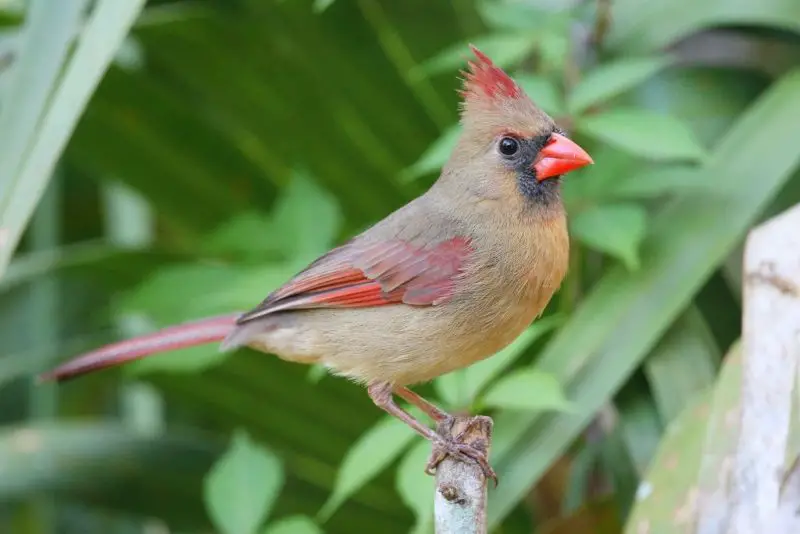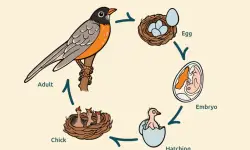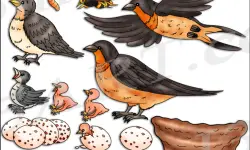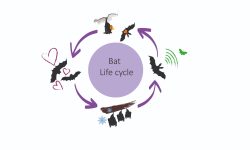The Northern Cardinal is one of the most recognized and beloved birds in North America, thanks to its striking red male counterpart. However, the female cardinal, while not as flamboyant, possesses a unique charm and plays a critical role in the species’ overall dynamics.
In this article, we delve into the fascinating traits of the female cardinal, covering everything from its physical characteristics and behavior to its habitat and nesting habits.
Physical Characteristics of the Female Cardinal

While the male cardinal is well-known for its vibrant red plumage, the female cardinal offers a more subtle, yet equally beautiful appearance. The female cardinal’s feathers are a mix of warm brown and red, with subtle highlights of reddish-orange around the crest and tail. Understanding these characteristics is important for birdwatchers and anyone interested in identifying the female cardinal in the wild.
Plumage Coloration
The female cardinal’s plumage features a combination of brown and red tones, with reddish highlights on its crest, wings, and tail. Unlike the bright red feathers of the male, the female’s coloration allows her to blend into her environment more effectively, especially when she’s perched in the underbrush or nesting.
This more muted coloration helps the female avoid predators while tending to her nest. Despite being less conspicuous than the male, the female cardinal still displays the characteristic crest and black mask around her face, which are features of the species.
Size and Shape
Female cardinals are slightly smaller than their male counterparts. On average, female cardinals measure about 8.3 to 9.1 inches in length and weigh between 1.5 to 1.8 ounces. Their bodies are stocky and robust, ideal for navigating dense vegetation, which is a critical part of their foraging and nesting behavior.
The female cardinal’s beak is short, thick, and orange-red, well-suited for cracking seeds, which make up a significant portion of her diet. This stout beak also aids in gathering food for her young during the breeding season.
Behavior and Social Structure
Female cardinals are often quieter and more reserved than their male counterparts, but they have fascinating behaviors that are integral to their survival and reproduction. From territorial habits to their role in parenting, the behavior of the female cardinal is crucial in maintaining the balance of the species.
Territoriality
Like their male counterparts, female cardinals can exhibit territorial behavior, particularly during the breeding season. While males are known for defending their territory with loud calls and displays of their bright plumage, females are more discreet in their defense of nesting sites. They may stay in the dense brush, keeping an eye on potential threats while also contributing to the protection of their territory.
Parental Role
The female cardinal is responsible for selecting the nesting site, often in dense shrubs or trees, where she can keep the eggs safe from predators. The male cardinal will often stay nearby, guarding the territory and bringing food to the female. Once the female lays her eggs, she incubates them for about 12 to 13 days before they hatch.
Both parents take turns feeding the hatchlings once they are born. The female typically feeds the young more frequently, but the male also helps in bringing food to the nest. This cooperative parenting ensures that the young cardinals grow strong and healthy.
Vocalizations
Although female cardinals are quieter than males, they do communicate through a variety of calls. These calls can range from soft chip notes to more complex songs used to communicate with their mate or alert others to the presence of danger. Female cardinals are also known to respond to the songs of males, especially during courtship.
While they may not sing as loudly or as frequently as males, female cardinals still possess an impressive vocal range and are important participants in the communication that occurs within cardinal pairs.
Habitat and Nesting Habits of the Female Cardinal
Cardinals, both male and female, are adaptable birds that thrive in a variety of environments, ranging from woodlands and forests to suburban gardens and city parks. Understanding the nesting habits and preferred habitats of the female cardinal can provide insight into her behavior and lifestyle.
Preferred Habitat
Female cardinals prefer dense, shrubby areas with plenty of cover. These areas provide safety for both the female and her offspring, as well as abundant food sources. While they can be found in woodlands, they are equally at home in suburban areas with bird feeders, hedges, and small trees. The presence of trees or tall shrubs is essential, as they help female cardinals build secure nests away from predators.
Cardinals are non-migratory birds, meaning that they remain in the same territory year-round. This also means that the female cardinal must rely on a consistent habitat for breeding and survival, including access to food and water sources.
Nesting Behavior
The nesting process is an intricate and essential part of the female cardinal’s life cycle. Female cardinals are responsible for constructing the nest, which is typically built in dense shrubs or the lower branches of trees. They create a well-hidden, cup-shaped nest using twigs, grasses, and leaves. The interior is often lined with fine materials such as feathers or soft plant down to ensure the comfort and safety of the eggs.
Once the nest is complete, the female cardinal will lay a clutch of three to four eggs, which are usually pale brown or greenish with speckled markings. After laying her eggs, she begins the incubation process, which lasts around 12 to 13 days.
Raising the Young
After the eggs hatch, both the male and female cardinal play active roles in caring for the chicks. The female is primarily responsible for brooding and feeding the young, although the male will help by bringing food to the nest. The young are altricial, meaning they are born helpless and require significant care from both parents.
As the chicks grow, they begin to fledge, or leave the nest, at around 10 to 14 days of age. At this stage, they are still dependent on their parents for food and protection, but they start learning to forage on their own.
Diet and Feeding Habits of the Female Cardinal
The female cardinal’s diet primarily consists of seeds, fruits, and insects. Her feeding habits are adapted to the availability of food in her environment, and she is known to be an opportunistic feeder. Below, we explore her diet in greater detail.
Seeds and Grains
Female cardinals are granivores, which means they eat a variety of seeds. Some of their favorites include sunflower seeds, safflower seeds, and millet. These seeds are high in energy and nutrients, which are essential for maintaining their health and supporting reproductive efforts. Female cardinals are particularly skilled at using their beaks to crack open tough seeds and access the nutritious insides.
In addition to seeds, they will often forage in areas where seeds are abundant, such as bird feeders or areas where native plants have produced seeds. They will also eat berries, such as those from holly or juniper bushes, depending on what’s available in their territory.
Insects and Protein Sources
While seeds make up a large portion of their diet, female cardinals also rely on protein sources like insects to meet their nutritional needs, especially during the breeding season. Insects such as beetles, grasshoppers, ants, and caterpillars are vital for providing the necessary protein to sustain energy levels.
During the warmer months, female cardinals will actively hunt for insects, either in flight or by foraging in the underbrush. This diet is particularly crucial when feeding their growing young, as the protein helps support rapid growth.
Conservation and Challenges Facing the Female Cardinal
The female cardinal, like many other bird species, faces a range of challenges due to habitat loss, climate change, and human activities. Understanding the potential threats to their survival is key to ensuring that these beautiful birds continue to thrive in the wild.
Habitat Loss
As human development spreads, much of the cardinal’s natural habitat is being destroyed. Urbanization, deforestation, and agricultural expansion reduce the number of suitable nesting sites for cardinals. This can lead to competition for space and resources, making survival more difficult.
Climate Change
Climate change also poses a threat to female cardinals and their ability to find food and suitable nesting environments. Warmer temperatures and unpredictable weather patterns can affect the availability of insects and seeds that are critical to their diet, making it harder for female cardinals to provide for their young.
Conservation Efforts
Many organizations and individuals are working to protect the cardinal’s habitat by creating bird-friendly spaces, planting native plants, and reducing the use of pesticides. Providing birdhouses and feeders can also help support the local cardinal population by giving them a safe and reliable food source.
Conclusion
The female cardinal is a unique and vital part of the cardinal species. While she may not be as brightly colored as the male, she is just as important in maintaining the balance of her ecosystem. Through her parenting, feeding habits, and territorial behavior, the female cardinal plays a significant role in ensuring the survival of her species. By understanding her traits, behavior, and challenges, we can better appreciate and support these fascinating birds in their natural environments.






